Optimizing the Positioning of Soil Moisture Monitoring Sensors in Winter Wheat Fields
Abstract
:1. Introduction
2. Materials and Methods
2.1. Experimental Site
2.2. Measurements
3. Results
3.1. Suitable Depth of Soil Moisture Monitoring
3.2. Relationship of Soil Moisture at Different Layers in the Soil Profile
3.3. Validation of the Results
3.4. Optimizing Irrigation Index of Winter Wheat with Border Irrigation
4. Discussion
5. Conclusions
- (1)
- Based on the analysis of soil water content and root distribution, the appropriate wetting layers using irrigation are 0–40 cm, 0–60 cm, and 0–100 cm during the early, middle, and last growth stages of winter wheat, respectively. This ensures crop growth and high irrigation water use efficiency.
- (2)
- As a result of the appropriate wetting layers, in order to measure soil water content and schedule irrigation accordingly, the recommended depths of placements of soil moisture monitoring instruments are 0–40 cm, 0–60 cm, and 0–100 cm during the early, middle, and last stages, respectively.
- (3)
- Observed SWC data at one depth in the soil profile is not representative enough to accurately calculate the average value of SWC for soil wetting layers. In order to accurately determine soil moisture content, we should investigate at least two observation points in the soil profile. The linear regression model can be built using SWC at depths of 10 and 30 cm to predict average SWC in the soil profile. The results of validation showed that the developed model provided reliable estimates of average SWC in the planned wetting layer. In brief, this study suggests that the suitable positioning of soil moisture sensors is at depths of 10 and 30 cm below the soil surface.
Author Contributions
Funding
Acknowledgments
Conflicts of Interest
References
- National Bureau of Statistics of China. China Statistical Yearbook 2016; China Statistics Press: Beijing, China, 2016. [Google Scholar]
- Yang, X.L.; Chen, Y.Q.; Pacenk, S.; Gao, W.S.; Ma, L.; Wang, G.Y.; Yan, P.; Sui, P.; Steenhuis, T.S. Effect of diversified crop rotations on groundwater levels and crop water productivity in the North China Plain. J. Hydrol. 2015, 522, 428–438. [Google Scholar] [CrossRef]
- Duan, A.W.; Meng, Z.J. Present situation of techniques and equipment of monitoring crop water status. Rev. Chin. Agric. Sci. Technol. 2007, 9, 6–14. [Google Scholar]
- Alamry, A.S.; Meijde, M.; Noomen, M.; Addink, E.A.; Benthem, R.; Jong, S.M. Spatial and temporal monitoring of soil moisture using surface electrical resistivity tomography in Mediterranean soils. Catena 2017, 157, 388–396. [Google Scholar] [CrossRef]
- Campbell, G.S.; Campbell, M.D. Irrigation scheduling using soil moisture measurements: Theory and practice. Adv. Irrig. 1982, 1, 25–42. [Google Scholar]
- Song, X.Y.; Yang, G.J.; Yang, C.H.; Wang, J.H.; Cui, B. Spatial variability analysis of within-field winter wheat nitrogen and grain quality using canopy fluorescence sensor measurements. Remote Sens. 2017, 9, 237. [Google Scholar] [CrossRef]
- Gardner, C.; Dean, T.; Cooper, J. Soil water content measurement with a high-frequency capacitance sensor. J. Agric. Eng. Res. 1998, 71, 395–403. [Google Scholar] [CrossRef]
- Blonquist, J.M; Jones, S.B.; Robinson, D.A. Precise irrigation scheduling for turfgrass using a subsurface electromagnetic soil moisture sensor. Agric. Water Manag. 2006, 84, 153–165. [Google Scholar] [CrossRef]
- Kędzior, M.; Zawadzki, J. Comparative study of soil moisture estimations from SMOS satellite mission, GLDAS database, and cosmic-ray neutrons measurements at COSMOS station in Eastern Poland. Geoderma 2016, 283, 21–31. [Google Scholar] [CrossRef]
- Luca, B.; Wade, T.C.; Luca, C.; Christian, M.; Patricia, D.R.; Markus, E.; Sebastian, H.; Giriraj, A.; Stefania, C.; Angelica, T.; et al. A review of the applications of ASCAT soil moisture products. IEEE J. Sel. Top. Appl. Earth Obs. Remote Sens. 2017, 10, 2285–2289. [Google Scholar]
- Shen, X.J.; Sun, J.S.; Zhang, J.Y.; Wang, J.L.; Li, M.S.; Yang, G.S. Study on the placement of sensors for moisture content in soil profile for cotton under mulched drip irrigation condition. Agricultural Research in the Arid Areas 2012, 30, 90–95. [Google Scholar]
- Wang, F.; Sun, J.S.; Liu, Z.G.; Ning, H.F.; Qiang, X.M; Shen, X.J. Sensor placement of soil water monitoring in cotton field using drip irrigation under plastic film mulch. J. Irrig. Drain. 2016, 35, 29–34. [Google Scholar]
- Yang, S.H.; Wang, Y.M.; Sun, K. Soil moisture content sensors placement based on the vertical variety law. Trans. Chin. Soc. Agric. Mach. 2008, 39, 104–107. [Google Scholar]
- Pogue, W.R.; Pooley, S.G. Tensiometric management of soil water. In Drip Trickle Irrigation in Action, Proceedings of the Third International Drip/Trickle Irrigation Congress, Fresno, CA, USA, 18–21 November 1985; American Society of Agricultural Engineers: St. Joseph, MI, USA, 1985; pp. 761–766. [Google Scholar]
- Haise, H.R.; Hagan, R.M. Soil, plant, and evaporative measurements as criteria for scheduling irrigation. Irrig. Agric. Lands 1967, Irrigationofagr, 577–604. [Google Scholar]
- Jensen, M.E. Design and Operation of Farm Irrigation Systems; American Society of Agricultural Engineers: St. Joseph, MI, USA, 1980. [Google Scholar]
- Gao, Y.; Liu, Z.D.; Duan, A.W.; Liu, Z.G.; Zhang, J.Y.; Sun, J.S. Laying depth of soil moisture probe in soil profile and data processing technology. J. Irrig. Drain. 2011, 30, 28–32. [Google Scholar]
- Machado, C.; Coelho, R. Estudo da distribuição espacial do sistema radicular do limão′Cravo′enxertado com lima ácida′Tahiti′. Laranja Cordeirópolis 2000, 21, 359–380. [Google Scholar]
- Reynolds, S.G. The gravimetric method of soil moisture determination. J. Hydrol. 1970, 11, 258–273. [Google Scholar] [CrossRef]
- Jha, S.K.; Gao, Y.; Liu, H.; Huang, Z.D.; Wang, G.S.; Liang, Y.Y.; Duan, A.W. Root development and water uptake in winter wheat under different irrigation methods and scheduling for North China. Agric. Water Manag. 2017, 182, 139–150. [Google Scholar] [CrossRef]
- Böhm, W. Methods of Studying Root Systems; Springer: Berlin, Germany, 1979. [Google Scholar]
- Tennant, D. A test of a modified line intersect method of estimating root length. J. Ecol. 1975, 63, 995–1001. [Google Scholar] [CrossRef]
- Arruda, F. Necessidade de água nas culturas-Elementos de projeto. Curso Prático Internacional de Agrometeorologia para Otimização da Irrigação 1989, 3, 30–35. [Google Scholar]
- Hartigan, J.A.; Wong, M.A. Algorithm AS 136: A k-means clustering algorithm. J. R. Stat. Soc. Ser. C (Appl. Stat.) 1979, 28, 100–108. [Google Scholar] [CrossRef]
- Meng, Z.J.; Duan, A.W.; Gao, Y.; Wang, X.S.; Shen, X.J.; Chang, X. Effect of regulated deficit irrigation on uptake and utilization of nitrogen, phosphorus and potassium for winter wheat. Trans. Chin. Soc. Agric. Mach. 2016, 47, 203–212. [Google Scholar]
- Shen, X.J.; Sun, J.S.; Liu, Z.G.; Zhang, J.P.; Liu, X.F. Effects of low irrigation limits on yield and grain quality of winter wheat. Trans. Chin. Soc. Agric. Eng. 2010, 26, 58–65. [Google Scholar]
- Zhang, X.Y.; Chen, S.Y.; Sun, H.Y.; Wang, Y.M.; Shao, L.W. Root size, distribution and soil water depletion as affected by cultivars and environmental factors. Field Crops Res. 2009, 114, 75–83. [Google Scholar] [CrossRef]
- Coelho, E.F.; Santos, D.B.; Azevedo, C.A. Sensor placement for soil water monitoring in lemon irrigated by micro sprinkler. Revista Brasileira Engenharia Agrícola Ambiental 2007, 11, 46–52. [Google Scholar] [CrossRef]
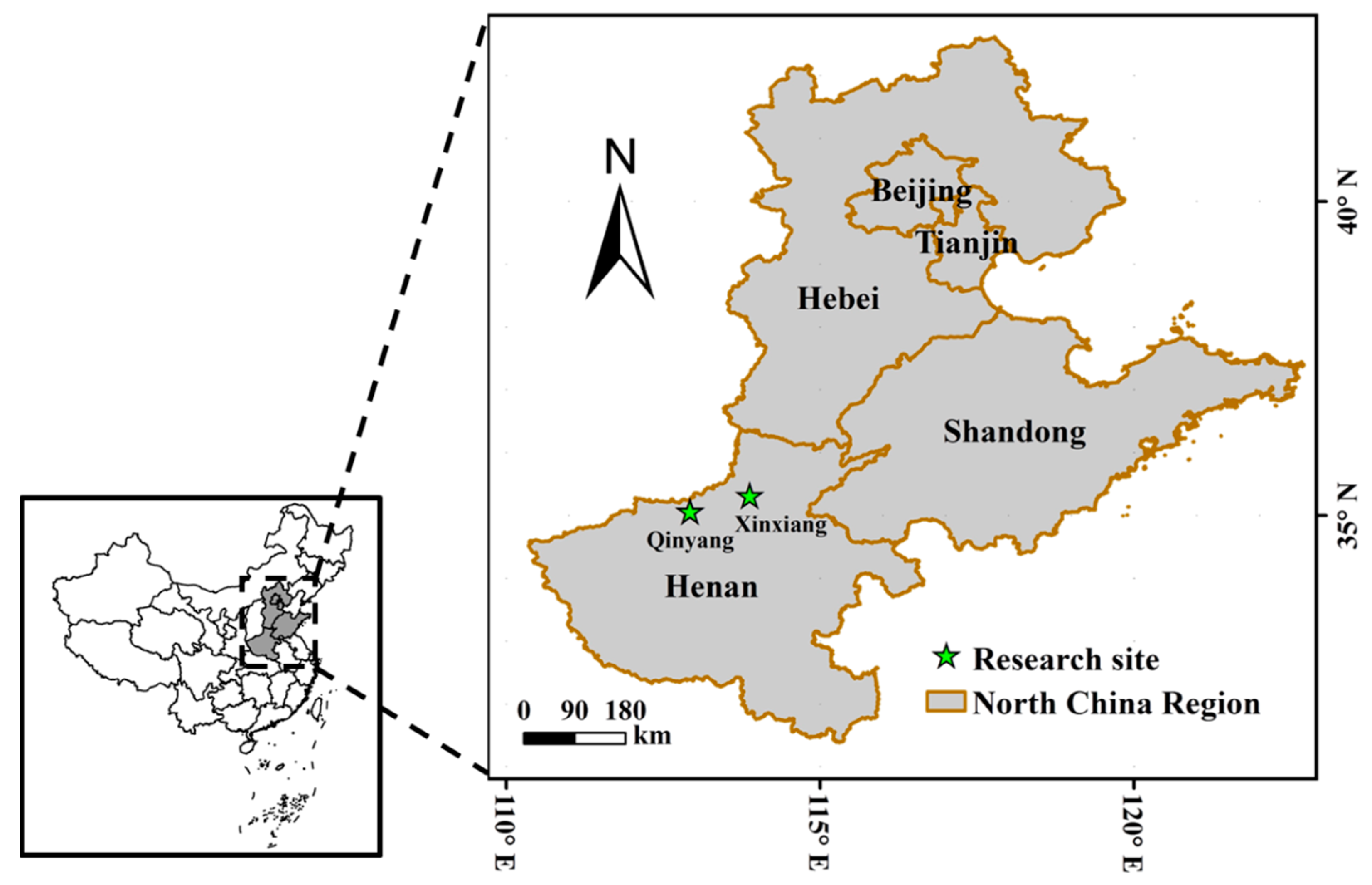
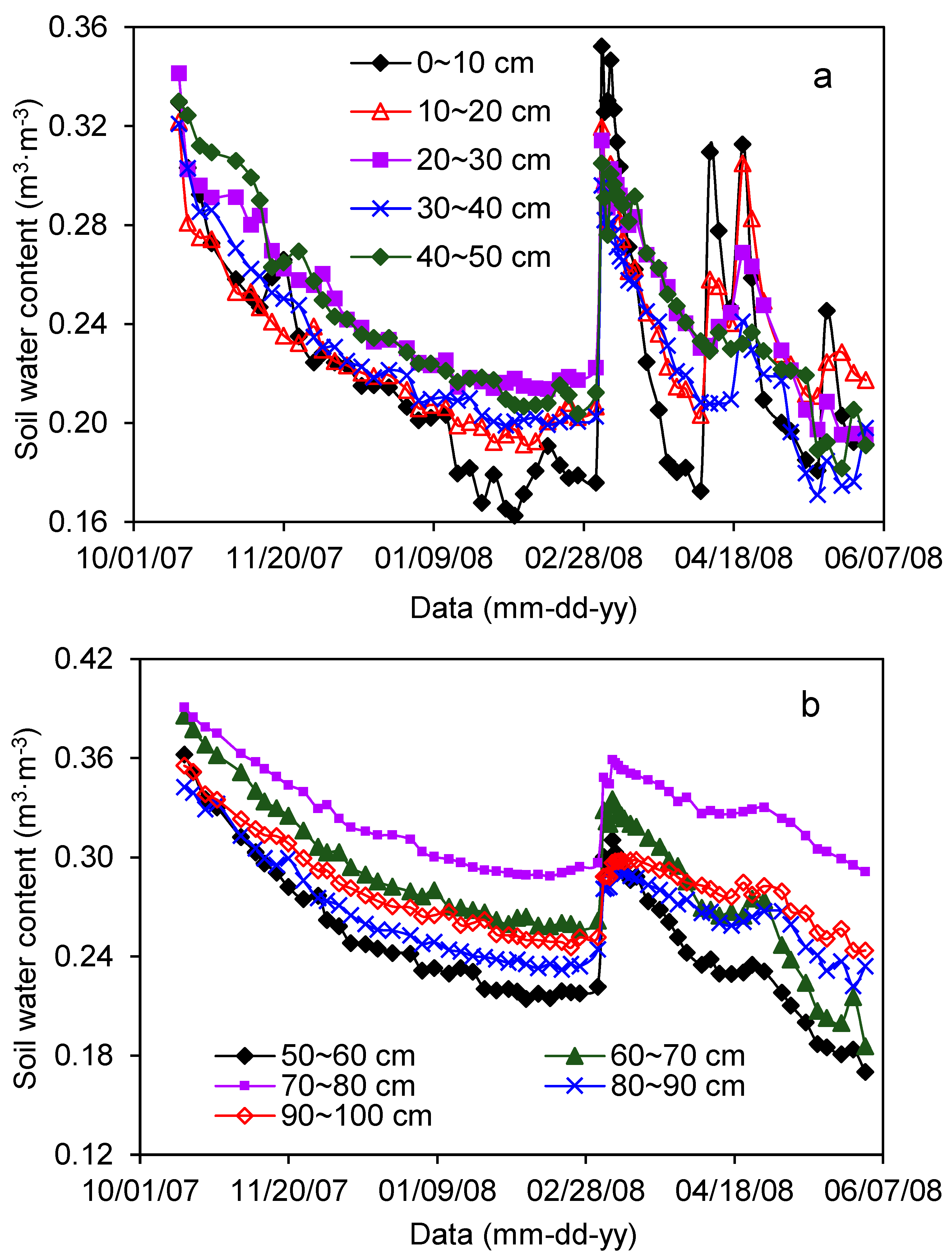
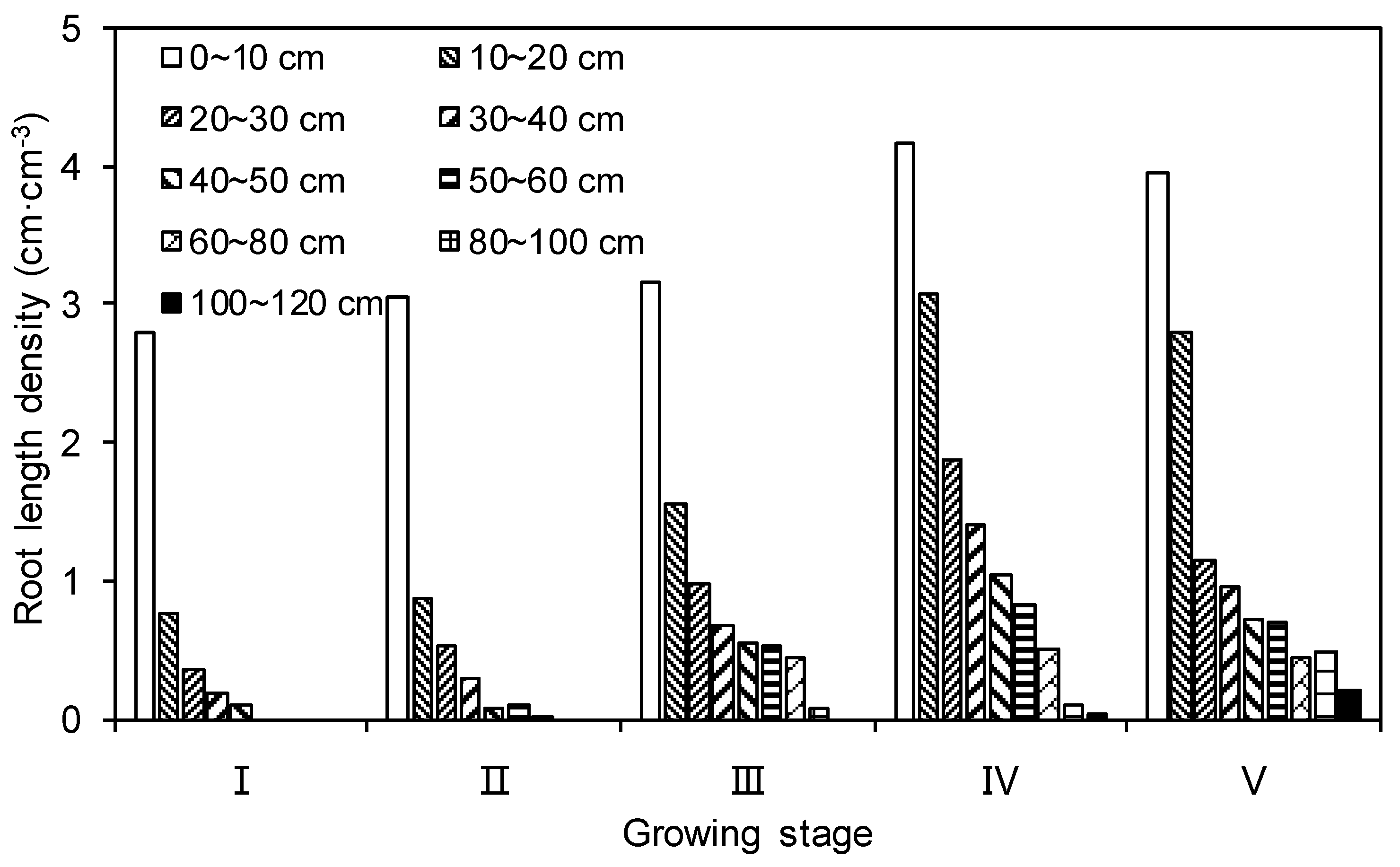
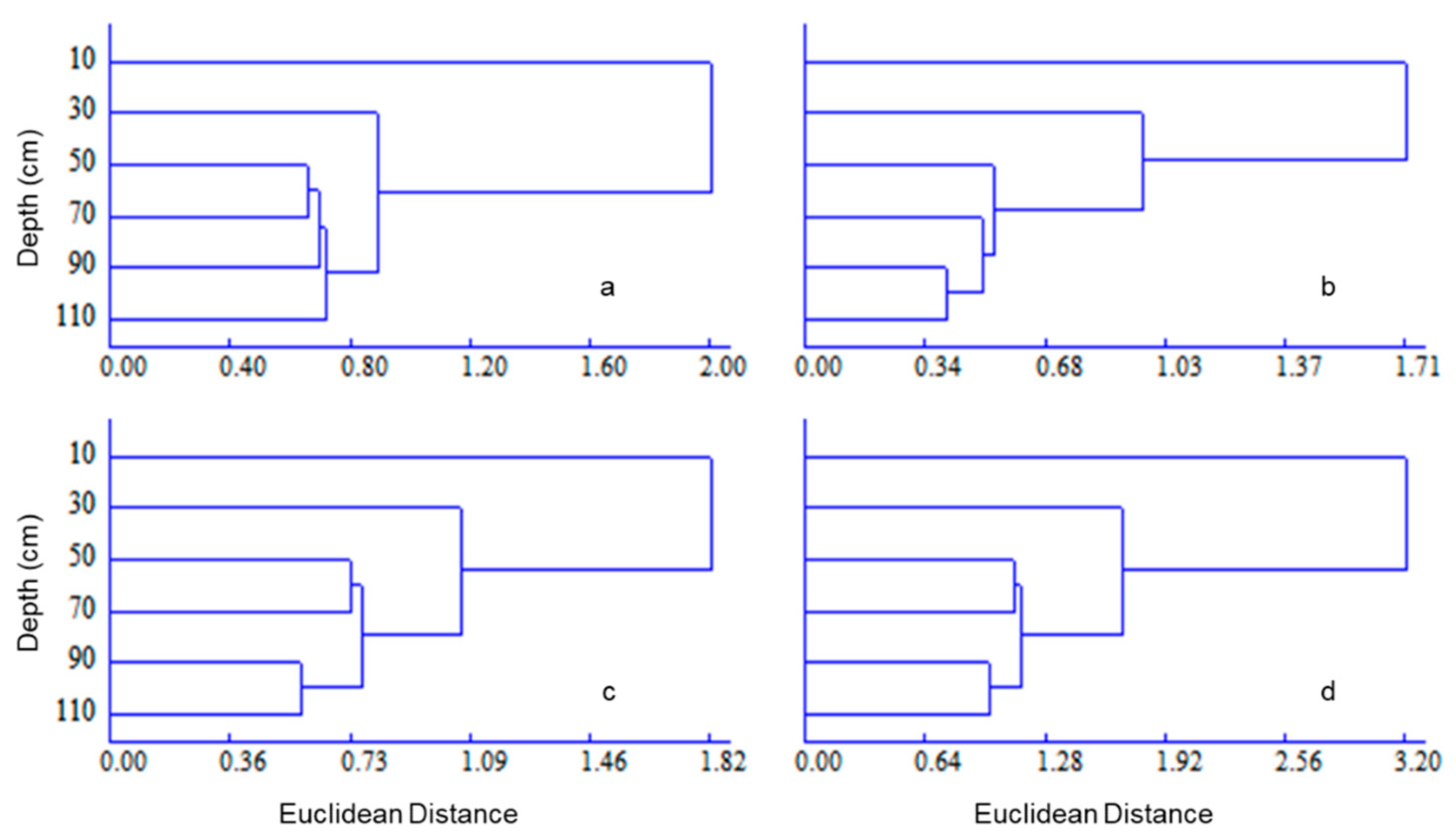
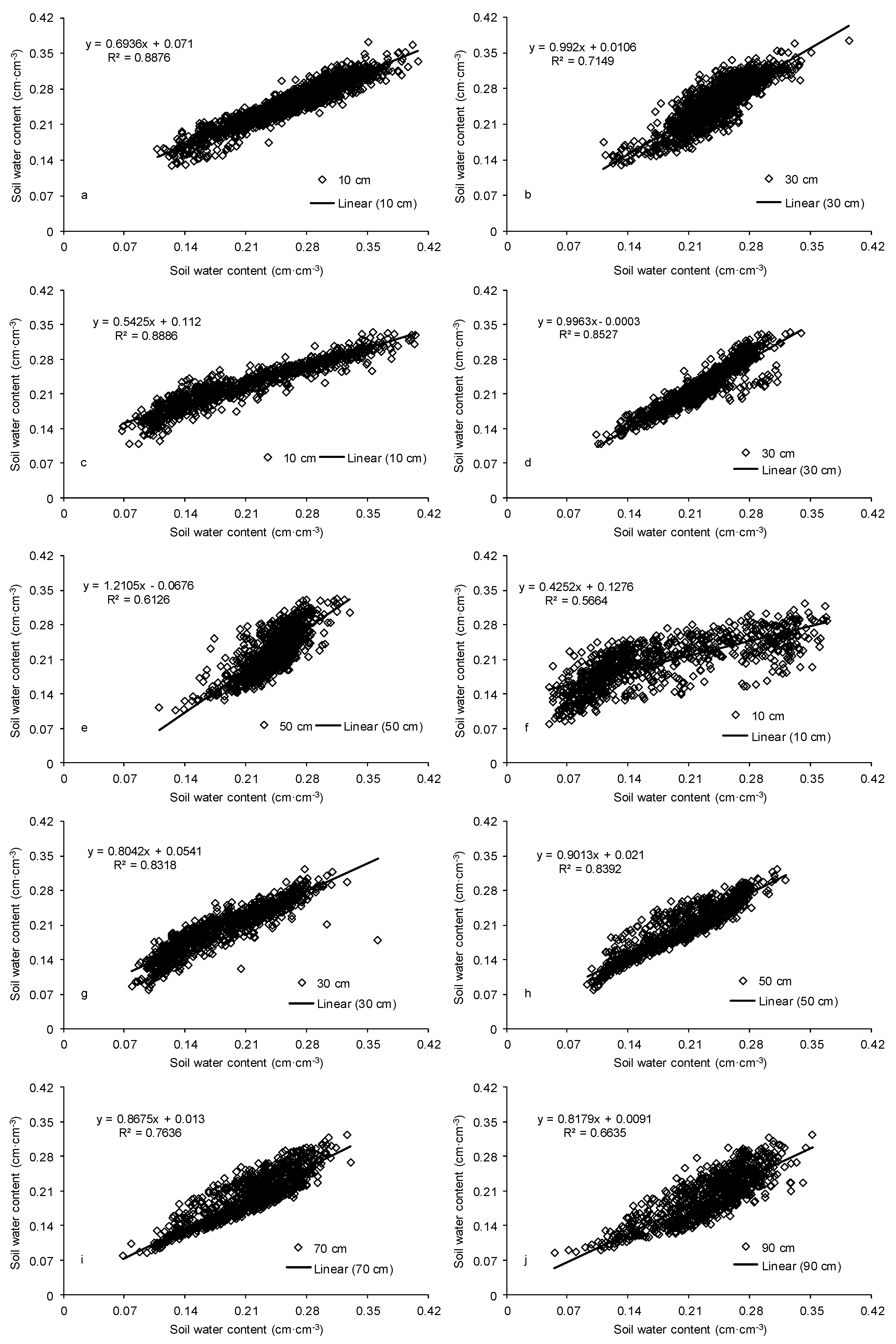
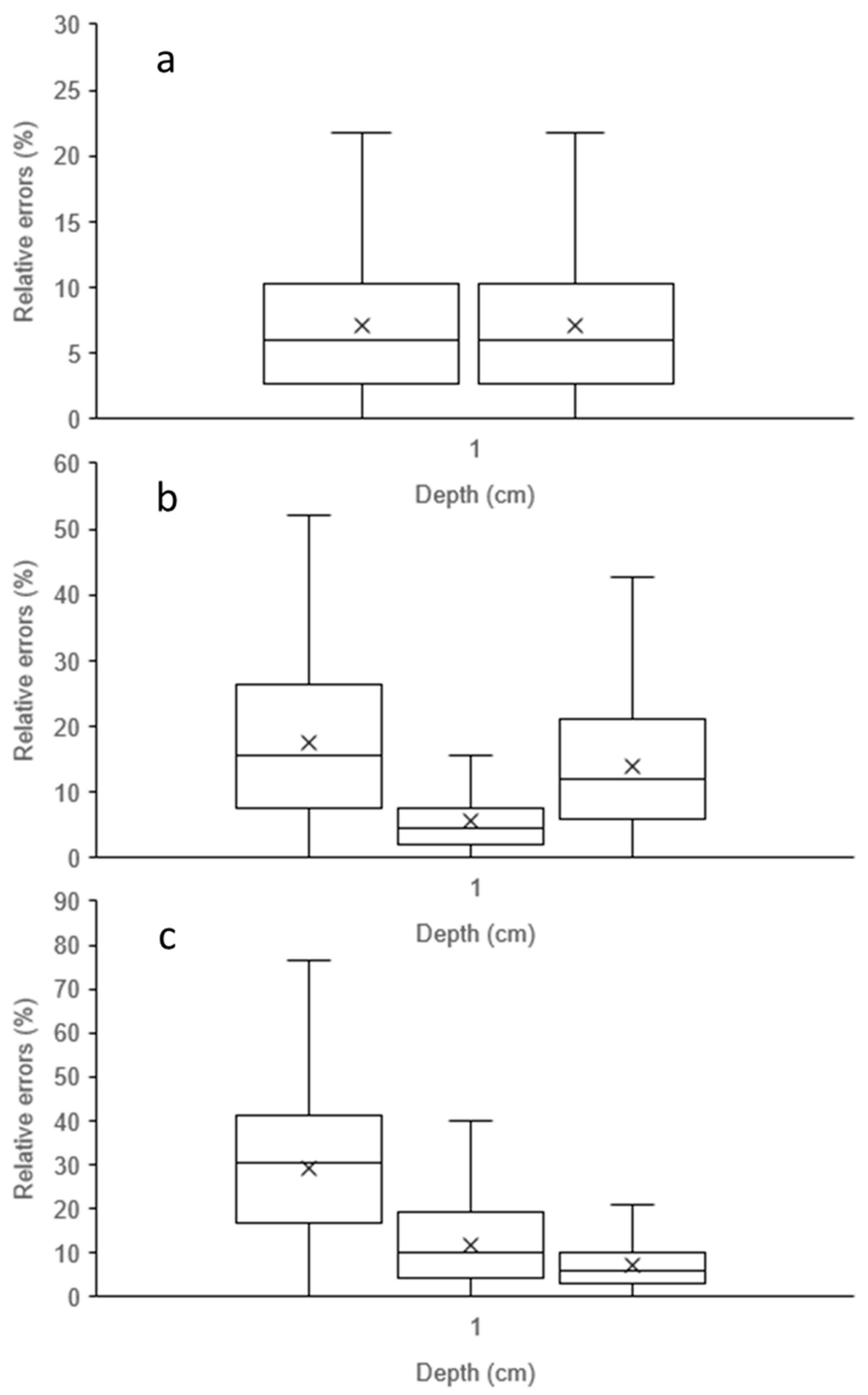
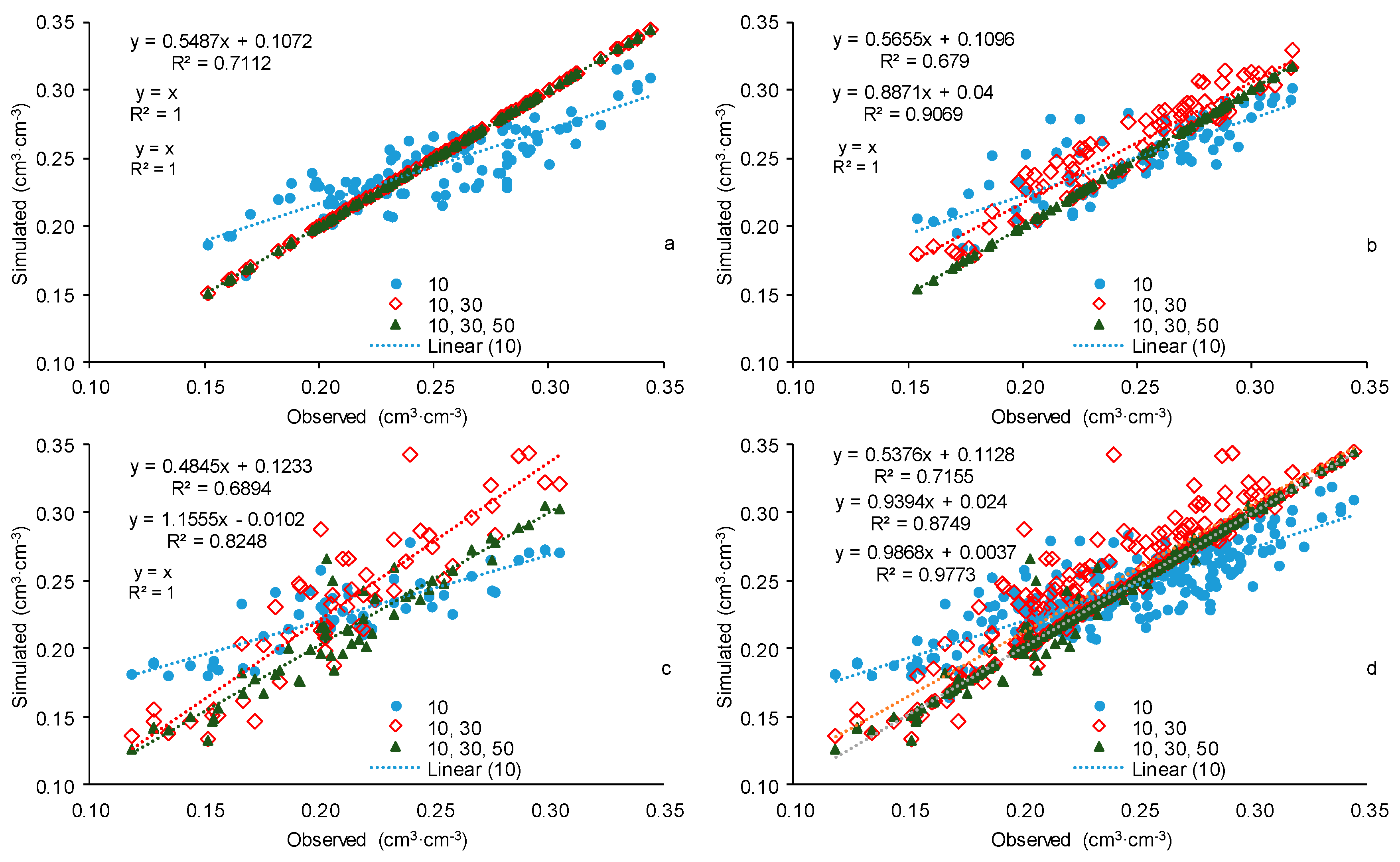
| Depth (cm) | Early Stage | Middle Stage | Last Stage | Whole Growing Season | ||||||||
|---|---|---|---|---|---|---|---|---|---|---|---|---|
| AV (cm3∙cm−3) | SD (cm3∙cm−3) | CV (%) | AV (cm3∙cm−3) | SD (cm3∙cm−3) | CV (%) | AV (cm3∙cm−3) | SD (cm3∙cm−3) | CV (%) | AV (cm3∙cm−3) | SD (cm3∙cm−3) | CV (%) | |
| 1998–1999 | n = 120 | n = 96 | n = 84 | n = 300 | ||||||||
| 0–20 | 0.226 | 0.053 | 23.6 | 0.224 | 0.067 | 29.96 | 0.146 | 0.06 | 41.25 | 0.203 | 0.071 | 34.93 |
| 20–40 | 0.239 | 0.034 | 14.49 | 0.221 | 0.043 | 19.74 | 0.162 | 0.051 | 31.82 | 0.212 | 0.054 | 25.5 |
| 40–60 | 0.263 | 0.023 | 8.79 | 0.258 | 0.023 | 8.99 | 0.197 | 0.04 | 20.87 | 0.243 | 0.042 | 17.47 |
| 60–80 | 0.271 | 0.018 | 6.7 | 0.271 | 0.016 | 5.82 | 0.214 | 0.034 | 16.2 | 0.254 | 0.036 | 14.21 |
| 80–100 | 0.275 | 0.015 | 5.67 | 0.28 | 0.01 | 3.48 | 0.238 | 0.027 | 11.47 | 0.266 | 0.027 | 10.26 |
| 100–120 | 0.28 | 0.013 | 4.75 | 0.286 | 0.007 | 2.42 | 0.258 | 0.019 | 7.52 | 0.275 | 0.02 | 7.17 |
| 2000–2001 | n = 168 | n = 168 | n = 96 | n = 432 | ||||||||
| 0–20 | 0.289 | 0.029 | 10.21 | 0.237 | 0.064 | 27.77 | 0.187 | 0.069 | 36.41 | 0.248 | 0.07 | 28.8 |
| 20–40 | 0.259 | 0.02 | 7.83 | 0.232 | 0.038 | 16.91 | 0.194 | 0.049 | 25.69 | 0.235 | 0.047 | 20.04 |
| 40–60 | 0.265 | 0.019 | 7.19 | 0.24 | 0.024 | 10.39 | 0.219 | 0.038 | 17.43 | 0.246 | 0.035 | 14.42 |
| 60–80 | 0.268 | 0.021 | 7.65 | 0.249 | 0.017 | 7.07 | 0.237 | 0.028 | 12.17 | 0.255 | 0.028 | 11.3 |
| 80–100 | 0.272 | 0.02 | 7.32 | 0.258 | 0.012 | 4.88 | 0.257 | 0.023 | 9.07 | 0.264 | 0.022 | 8.46 |
| 100–120 | 0.278 | 0.019 | 6.93 | 0.266 | 0.014 | 5.1 | 0.273 | 0.024 | 8.7 | 0.274 | 0.022 | 7.97 |
| 2001–2002 | n = 900 | n = 360 | n = 600 | n = 1860 | ||||||||
| 0–20 | 0.261 | 0.054 | 21.38 | 0.192 | 0.069 | 35.81 | 0.158 | 0.063 | 38.19 | 0.224 | 0.078 | 35.37 |
| 20–40 | 0.237 | 0.021 | 8.99 | 0.22 | 0.032 | 14.86 | 0.195 | 0.031 | 16.41 | 0.224 | 0.034 | 15.73 |
| 40–60 | 0.242 | 0.016 | 6.88 | 0.236 | 0.02 | 9.03 | 0.215 | 0.021 | 10.3 | 0.235 | 0.026 | 11.61 |
| 60–80 | 0.244 | 0.011 | 4.84 | 0.245 | 0.015 | 6.55 | 0.233 | 0.015 | 6.68 | 0.242 | 0.021 | 8.92 |
| 80–100 | 0.251 | 0.008 | 3.15 | 0.253 | 0.012 | 5 | 0.247 | 0.01 | 4.16 | 0.251 | 0.017 | 6.73 |
| 100–120 | 0.261 | 0.007 | 2.61 | 0.262 | 0.01 | 3.99 | 0.259 | 0.008 | 3.3 | 0.261 | 0.015 | 5.65 |
| 2003–2004 | n = 264 | n = 144 | n = 120 | n = 528 | ||||||||
| 0–20 | 0.24 | 0.042 | 17.8 | 0.197 | 0.069 | 34.7 | 0.195 | 0.076 | 39.77 | 0.22 | 0.064 | 29.59 |
| 20–40 | 0.248 | 0.031 | 12.92 | 0.212 | 0.037 | 17.8 | 0.205 | 0.048 | 23.98 | 0.23 | 0.043 | 19 |
| 40–60 | 0.252 | 0.017 | 6.7 | 0.24 | 0.013 | 5.54 | 0.224 | 0.016 | 7.35 | 0.243 | 0.021 | 8.71 |
| 60–80 | 0.259 | 0.012 | 4.76 | 0.251 | 0.009 | 3.65 | 0.24 | 0.017 | 7.44 | 0.252 | 0.016 | 6.44 |
| 80–100 | 0.265 | 0.012 | 4.46 | 0.261 | 0.009 | 3.43 | 0.255 | 0.018 | 7.11 | 0.262 | 0.014 | 5.33 |
| 100–120 | 0.273 | 0.011 | 4.04 | 0.269 | 0.008 | 3 | 0.265 | 0.019 | 7.23 | 0.27 | 0.014 | 5.16 |
| 2004–2005 | n = 660 | n = 300 | n = 300 | n = 1260 | ||||||||
| 0–20 | 0.262 | 0.035 | 13.33 | 0.19 | 0.07 | 36.87 | 0.18 | 0.078 | 42.15 | 0.226 | 0.075 | 33.49 |
| 20–40 | 0.243 | 0.027 | 11.24 | 0.225 | 0.033 | 14.73 | 0.16 | 0.03 | 18.65 | 0.219 | 0.048 | 22.41 |
| 40–60 | 0.251 | 0.017 | 6.92 | 0.237 | 0.013 | 5.47 | 0.166 | 0.026 | 16.42 | 0.227 | 0.041 | 18.52 |
| 60–80 | 0.249 | 0.013 | 5.16 | 0.237 | 0.008 | 3.52 | 0.182 | 0.03 | 17.65 | 0.23 | 0.034 | 15.25 |
| 80–100 | 0.25 | 0.008 | 3.36 | 0.244 | 0.005 | 2.2 | 0.203 | 0.032 | 17.4 | 0.237 | 0.027 | 11.64 |
| 100–120 | 0.243 | 0.007 | 2.89 | 0.24 | 0.004 | 1.86 | 0.209 | 0.029 | 14.96 | 0.234 | 0.021 | 9.56 |
| Depth | 10 cm | 30 cm | 50 cm | 70 cm | 90 cm | 110 cm |
|---|---|---|---|---|---|---|
| 10 cm | 1 | |||||
| 30 cm | 0.9069 | 1 | ||||
| 50 cm | 0.8856 | 0.9975 | 1 | |||
| 70 cm | 0.8782 | 0.9959 | 0.9996 | 1 | ||
| 90 cm | 0.8751 | 0.9950 | 0.9992 | 0.9998 | 1 | |
| 110 cm | 0.8736 | 0.9946 | 0.9990 | 0.9997 | 0.9999 | 1 |
| Growing Stage | Depth (cm) | Number of Classical | Growing Stage | Depth (cm) | Number of Classical | ||||||||
|---|---|---|---|---|---|---|---|---|---|---|---|---|---|
| 2 | 3 | 4 | 5 | 6 | 2 | 3 | 4 | 5 | 6 | ||||
| Early stage | 10 | 1 | 1 | 1 | 1 | 1 | Last stage | 10 | 1 | 1 | 1 | 1 | 1 |
| 30 | 1 | 2 | 2 | 2 | 2 | 30 | 1 | 2 | 2 | 2 | 2 | ||
| 50 | 2 | 3 | 3 | 3 | 3 | 50 | 2 | 3 | 3 | 3 | 3 | ||
| 70 | 2 | 3 | 3 | 3 | 4 | 70 | 2 | 3 | 4 | 4 | 4 | ||
| 90 | 2 | 3 | 3 | 4 | 5 | 90 | 2 | 3 | 4 | 5 | 5 | ||
| 110 | 2 | 3 | 4 | 5 | 6 | 110 | 2 | 3 | 4 | 5 | 6 | ||
| Middle stage | 10 | 1 | 1 | 1 | 1 | 1 | Whole growing season | 10 | 1 | 1 | 1 | 1 | 1 |
| 30 | 1 | 2 | 2 | 2 | 2 | 30 | 1 | 2 | 2 | 2 | 2 | ||
| 50 | 2 | 3 | 3 | 3 | 3 | 50 | 2 | 3 | 3 | 3 | 3 | ||
| 70 | 2 | 3 | 3 | 4 | 4 | 70 | 2 | 3 | 3 | 4 | 4 | ||
| 90 | 2 | 3 | 4 | 5 | 5 | 90 | 2 | 3 | 4 | 5 | 5 | ||
| 110 | 2 | 3 | 4 | 5 | 6 | 110 | 2 | 3 | 4 | 5 | 6 | ||
| Depth (cm) | Early Stage | Middle Stage | Last Stage | ||||||
|---|---|---|---|---|---|---|---|---|---|
| AV (cm3∙cm−3) | SD (cm3∙cm−3) | CV (%) | AV (cm3∙cm−3) | SD (cm3∙cm−3) | CV (%) | AV (cm3∙cm−3) | SD (cm3∙cm−3) | CV (%) | |
| n = 1944 | n = 942 | n = 910 | |||||||
| 10 | 0.26 | 0.05 | 20.47 | 0.21 | 0.08 | 37.79 | 0.17 | 0.08 | 49.08 |
| 30 | 0.24 | 0.03 | 13.77 | 0.22 | 0.04 | 18.42 | 0.18 | 0.05 | 29.59 |
| 50 | 0.24 | 0.03 | 12.01 | 0.20 | 0.05 | 24.21 | |||
| 70 | 0.22 | 0.05 | 22.12 | ||||||
| 90 | 0.23 | 0.05 | 20.02 | ||||||
| Planned wetting layer | 0.25 | 0.04 | 15.6 | 0.22 | 0.04 | 19.98 | 0.2 | 0.05 | 23.68 |
| Growing Stage | Number of Monitoring Points | Equations | R2 |
|---|---|---|---|
| Early stage | 1 | 0.8876 | |
| 2 | 1.0000 | ||
| Middle stage | 1 | 0.8859 | |
| 2 | 0.9806 | ||
| 3 | 1.0000 | ||
| Last stage | 1 | 0.5664 | |
| 2 | 0.9135 | ||
| 3 | 0.9750 |
| Growing Stage | Suitable Low Irrigation Limit | Suitable Irrigation Quota (mm) | ||
|---|---|---|---|---|
| Based on SWC in Planned Wetted Layer | Based on SWC at Proper Positions of SMSs | |||
| Early stage | Sowing to reviving stage | 50% FC | 75 | |
| Middle stage | Returning green and jointing stages | 65% FC | 75 | |
| Last stage | heading to Flowering stage | 70% FC | 75 | |
| Filling to ripening stage | 60% FC | 75 | ||
© 2018 by the authors. Licensee MDPI, Basel, Switzerland. This article is an open access article distributed under the terms and conditions of the Creative Commons Attribution (CC BY) license (http://creativecommons.org/licenses/by/4.0/).
Share and Cite
Shen, X.; Liang, J.; Zeleke, K.T.; Liang, Y.; Wang, G.; Duan, A.; Mi, Z.; Ning, H.; Gao, Y.; Zhang, J. Optimizing the Positioning of Soil Moisture Monitoring Sensors in Winter Wheat Fields. Water 2018, 10, 1707. https://doi.org/10.3390/w10121707
Shen X, Liang J, Zeleke KT, Liang Y, Wang G, Duan A, Mi Z, Ning H, Gao Y, Zhang J. Optimizing the Positioning of Soil Moisture Monitoring Sensors in Winter Wheat Fields. Water. 2018; 10(12):1707. https://doi.org/10.3390/w10121707
Chicago/Turabian StyleShen, Xiaojun, Jing Liang, Ketema Tilahun Zeleke, Yueping Liang, Guangshuai Wang, Aiwang Duan, Zhaorong Mi, Huifeng Ning, Yang Gao, and Jiyang Zhang. 2018. "Optimizing the Positioning of Soil Moisture Monitoring Sensors in Winter Wheat Fields" Water 10, no. 12: 1707. https://doi.org/10.3390/w10121707
APA StyleShen, X., Liang, J., Zeleke, K. T., Liang, Y., Wang, G., Duan, A., Mi, Z., Ning, H., Gao, Y., & Zhang, J. (2018). Optimizing the Positioning of Soil Moisture Monitoring Sensors in Winter Wheat Fields. Water, 10(12), 1707. https://doi.org/10.3390/w10121707











